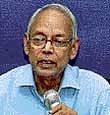'Two more tests to improve H-bomb'

As a way of bolstering his fizzle claims, Santhanam said a 50-page DRDO report submitted to the government months after the May 1998 tests stated that the test yields were far lower than the claims made by the Department of Atomic Energy (DAE). But the DAE is believed to have given a point-by-point rebuttal to the DRDO report, which was authored originally by Santhanam. Both documents are classified.
The scientist who retired from the Defence Research and Development Organisation (DRDO) and Institute for Defence Studies and Analysis (IDSA) called for an independent probe to verify claims that the DAE has made on H-bomb. The DAE has consistently maintained that the H-bomb test yield was 45 kt.
Top scientists, including Santhanam who was then deputy to APJ Abdul Kalam at DRDO, had claimed after the “Shakti-tests” that atomic scientists should be able to improve the weapons by computer simulation based on the data collected from the tests. Western scientists, however, questioned India’s claim on the yields of H-bomb test, sparking-off widespread debate on the original result.
Santhanam re-ignited the debate last month, raising questions over the H-bomb yield,11 years after the tests were conducted. The doubts resurface at a time when the Obama administration is having a change in perception on the Comprehensive Test Ban Treaty (CTBT), leading to apprehensions over New Delhi's motives in changing its stance.
Santhanam said he had based his views of the test on DRDO’s instrumentations at ground zero, which, DAE officials have suggested, had malfunctioned on the day of the test. The former DRDO scientist—also a nuclear physicist trained at the Bhabha Atomic Research Centre—argued that the H-bomb test failed since a 45 kt test at a depth of more than 100 mt could have created a huge crater on the ground, while none was found after the test.
Scientists said such assertions are flawed, as a different methodology (related to the volume effect of the explosion) would be applicable to determine the crater size in case of a fusion bomb. Santhanam claimed that the DAE never made the detailed radio-chemical analysis public to justify its claim on 45 kt yield. He said there are two DRDO units which have capabilities to independently analyse the radio-chemical data to verify DAE’s assessment.